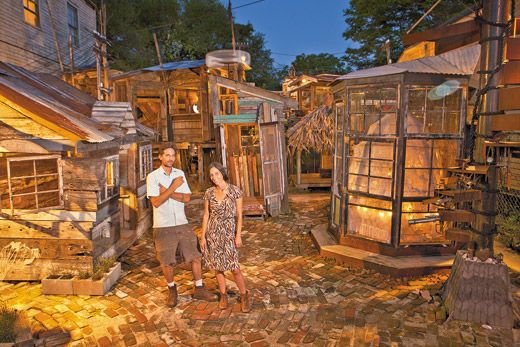You’ve Never Heard A Music Box Like This
In a funky New Orleans experiment, musicians turn a ramshackle house into a cacophony of sounds
/https://tf-cmsv2-smithsonianmag-media.s3.amazonaws.com/filer/FOB-New-Orleans-631.jpg)
At first glance, the ramshackle structure looks like something out of Spanky and “Our Gang”—a kid-size shantytown cobbled together without adult supervision from old lumber and junkyard castoffs. This is no playground, however. The Music Box, in the historic Bywater section of New Orleans, is a new performance space consisting of nine shacks, rigged by a team of musicians, artists, inventors and tinkerers to coax novel sounds from salvaged building materials—musical architecture.
“I thought that a fun way to grapple with what we meant by musical architecture would be to make a village of small structures, and for each one to be a sound artist’s laboratory,” says Delaney Martin, co-founder of an arts organization called New Orleans Airlift, who has guided the Music Box from its inception.
The shanties were erected with materials salvaged mainly from an 18th-century Creole cottage that collapsed on the site in 2009—everything from mahogany paneling to rattraps.
The new instruments inside are Rube Goldberg contraptions that bring to mind the ingenuity of Southern jug bands. There’s a twisting staircase that pumps out tones from organ parts retrieved from a church flooded during Hurricane Katrina; a giant stand-up bass with a weed-whacker line for a string and a bathtub for a resonator; a tall, weather-vane–like structure hooked up to an analog synthesizer. “It reacts to rain, sunlight and wind velocity and uses those variables to modulate an ever-present, droning E major chord,” explains its inventor, Quintron, a New Orleans musician who conducts Music Box performances. The concerts attract hundreds who wait in line for a chance to sit in a small set of bleachers.
Guest artists have included Dickie Landry, a co-founder of the Philip Glass Ensemble; Mannie Fresh, the veteran New Orleans hip-hop producer; and cellist Helen Gillet—all taking on the newfangled instruments. (Rock guitarist Nels Cline of Wilco recently joined the future roster.) Doug MacCash, a Times-Picayune music critic, characterized a recent Music Box performance as a symphony of “clacking, chiming, thumping, whirring sounds [that] somehow blended into a haunting whole.”
The hope is eventually to build a 45-foot-high musical house called Dithyrambalina, designed by Callie Curry, the renowned Brooklyn-based installation artist, known to the wider public as Swoon.
The can-do spirit comes as no surprise to Quintron. “This is just what we do in New Orleans,” he says. “It’s a kooky town, full of great musicians that just can’t keep their hands still, building stuff and tearing it down and inventing newness out of rubble.”
Planning Your Next Trip?
Explore great travel deals
Smithsonian magazine participates in affiliate link advertising programs. If you purchase an item through these links, we receive a commission.
/https://tf-cmsv2-smithsonianmag-media.s3.amazonaws.com/accounts/headshot/Jamie-Katz-240.jpg)

/https://tf-cmsv2-smithsonianmag-media.s3.amazonaws.com/accounts/headshot/Jamie-Katz-240.jpg)